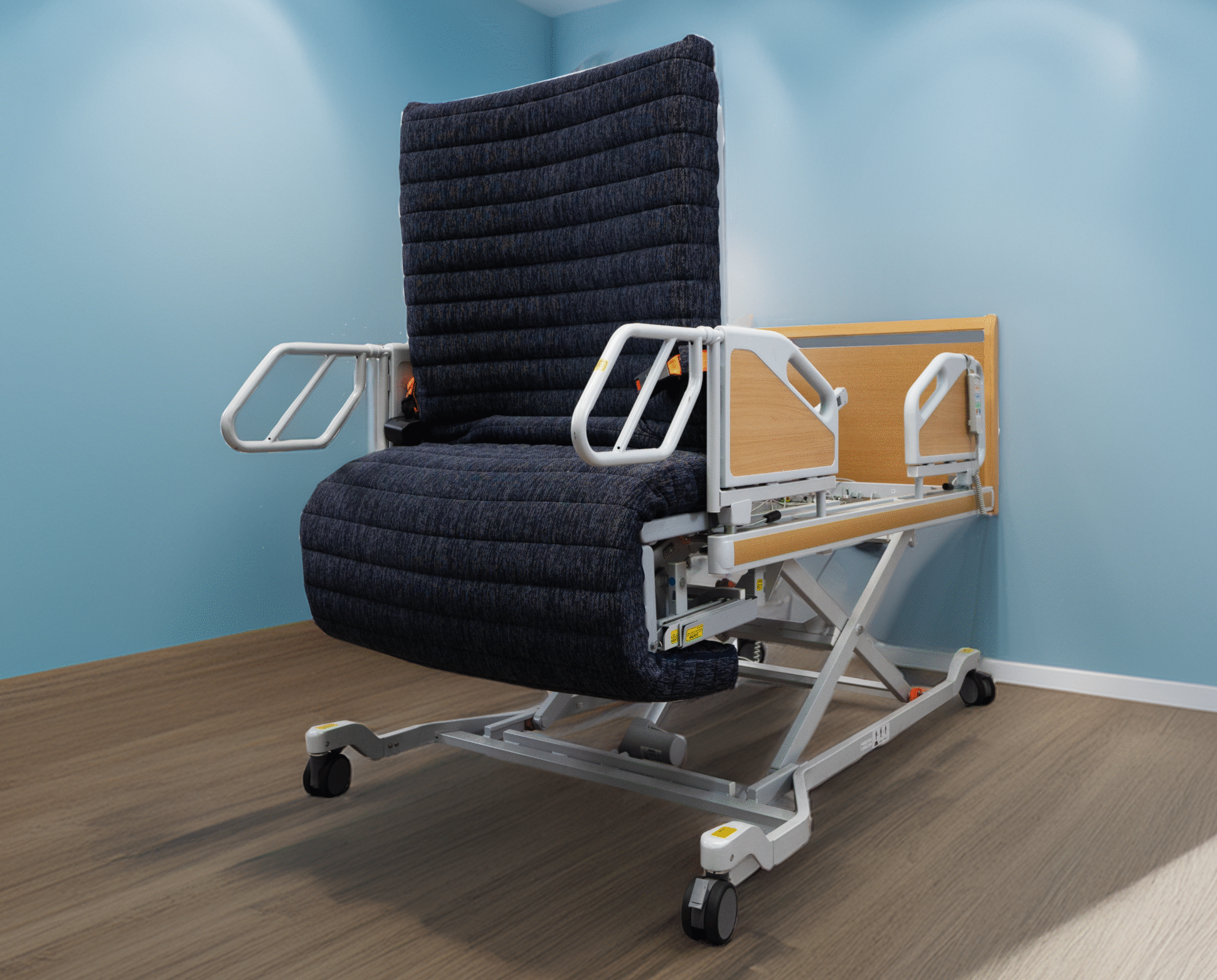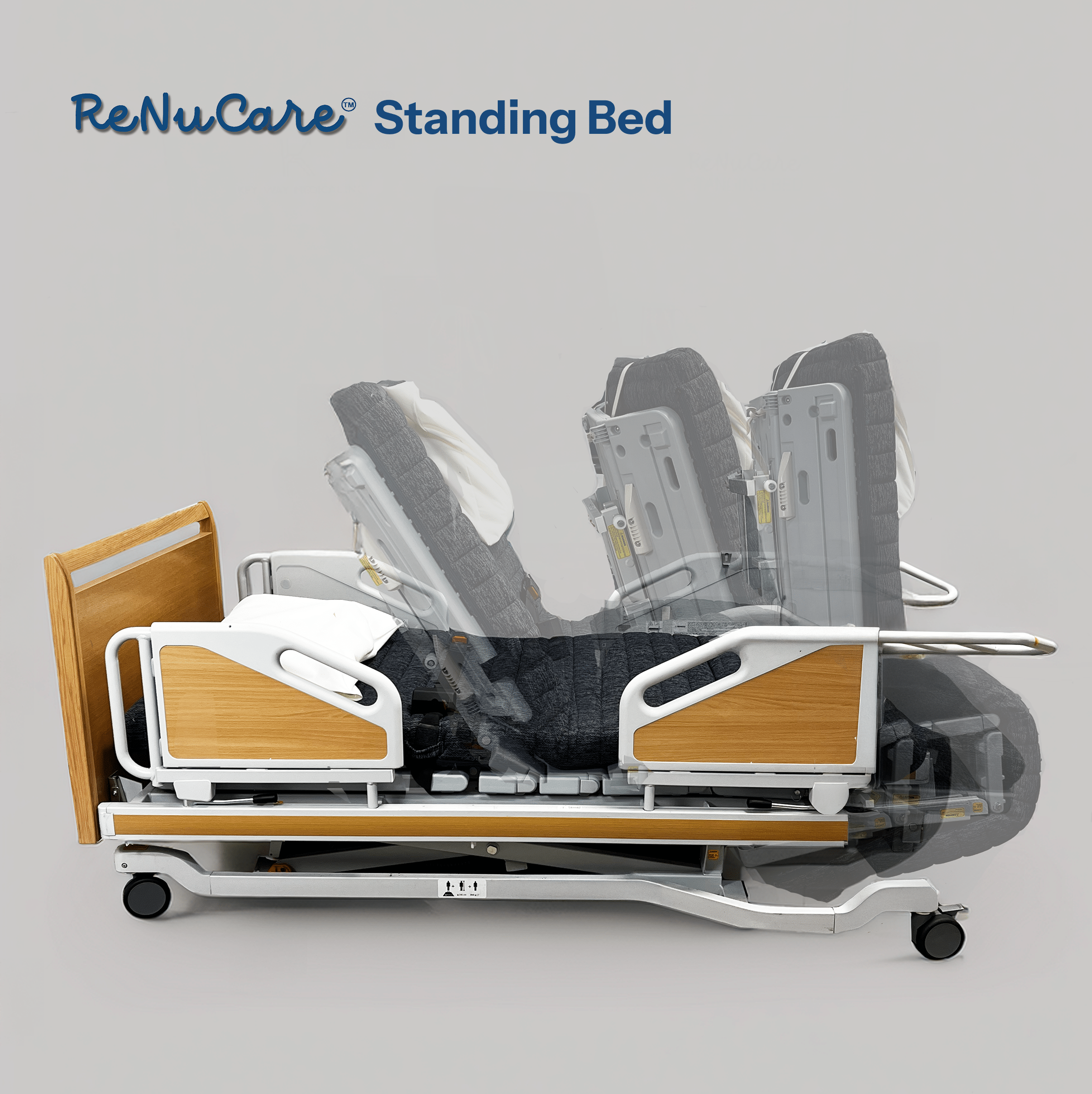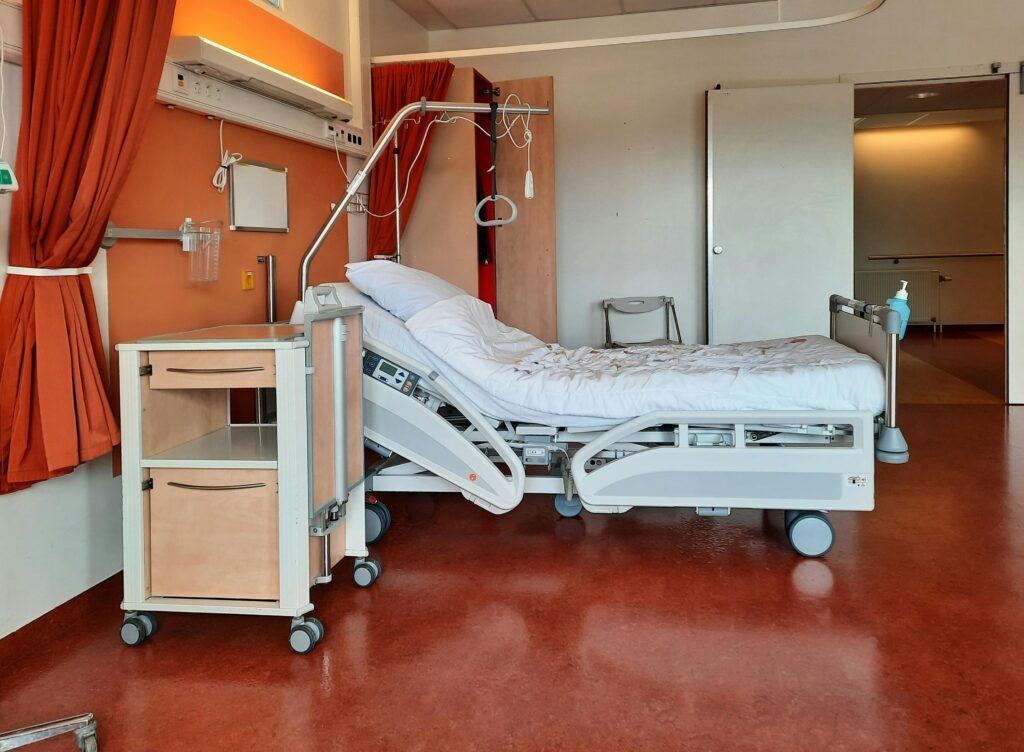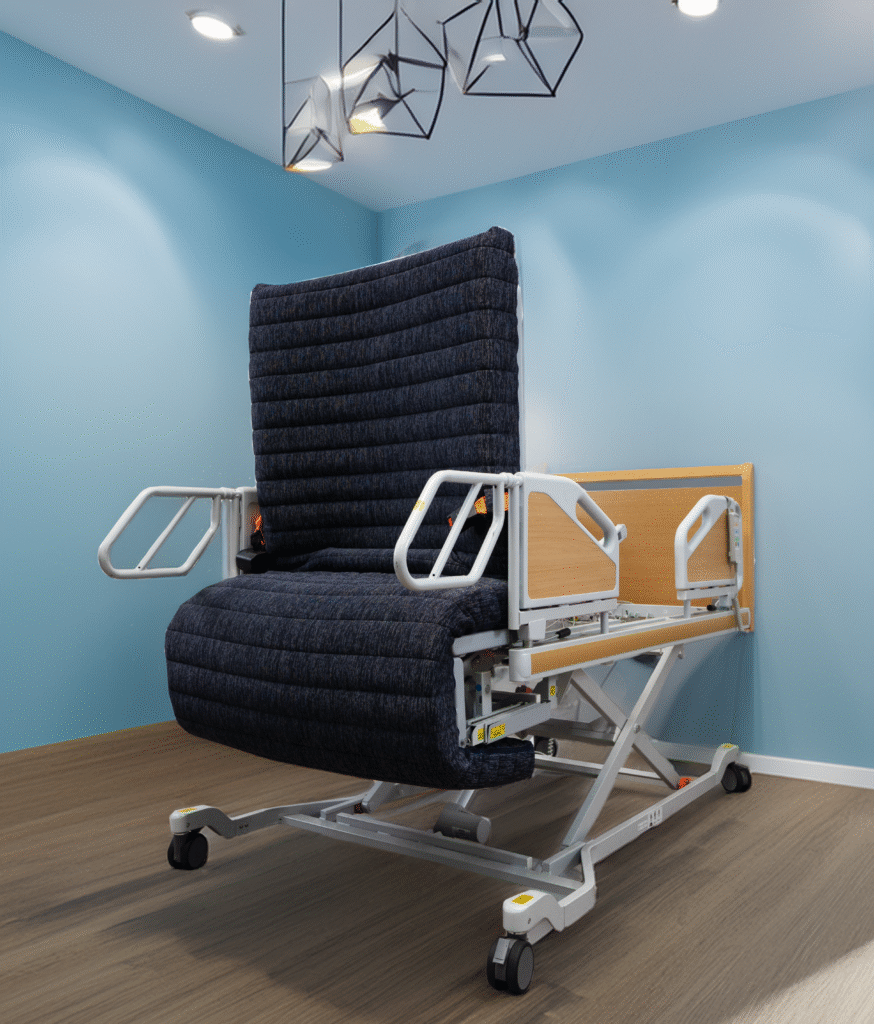
Difference Between a Standing Bed and Electric Hospital Bed
When comparing a standing bed to a traditional electric hospital bed, the difference lies in independence, safety, and mobility. The ReNuCare Standing Bed is not just an adjustable hospital bed; it is a true medical-grade bed-to-stand solution that transitions users from lying flat to fully standing. Designed for long-term care, rehabilitation, and home use, it helps patients regain independence while reducing caregiver strain. Unlike standard hospital beds that only adjust for comfort, the ReNuCare Standing Bed actively supports muscle engagement, improves circulation, and aids in faster recovery. Its advanced lift system promotes safer transfers and reduces fall risks, making it an ideal solution for individuals with limited mobility or those recovering from surgery, stroke, or injury.

What Is a Standing Bed?
A standing bed is an advanced medical device that helps patients safely transition from a lying position to a full standing position. The ReNuCare Standing Bed, an FDA Class II medical device, allows users to stand with both feet planted on the floor, enabling easy transfers to a wheelchair or walker. This design minimizes the risk of back injuries for caregivers and eliminates the need for separate lifting equipment.
In contrast, most electric hospital beds or rotating 90-degree beds stop at an upright sitting position, requiring manual assistance or a lift system to help the user stand. The ReNuCare Standing Bed bridges this gap by integrating a full bed-to-stand mechanism that supports users through every stage of movement. It is particularly beneficial for individuals recovering from spinal cord injuries, strokes, or muscle weakness, as it promotes safe, gradual mobility without additional strain. By encouraging regular standing, the bed also helps prevent complications such as bedsores, poor circulation, and muscle atrophy, which are common in long-term bed care.

Key Differences Between a Standing Bed and a Hospital Bed
1. True Stand-Assist vs. 90-Degree Chair Position
ReNuCare Standing Bed: Moves smoothly from flat to reclined, then to seated, and finally to a full standing position. The final position is a stable, weight-bearing stance with both feet on the floor, allowing users to easily pivot or transfer to a wheelchair or walker. This full-motion design restores independence and dignity for users who would otherwise need help getting out of bed. It also helps caregivers avoid physical strain or back injuries that often occur when lifting or repositioning patients manually.
Rotating or 90-Degree Beds: Stop at a seated position, leaving users dependent on caregivers for transfers. While they can help with repositioning and make it easier to sit upright, they do not complete the transition to a true standing posture. As a result, many users still need additional equipment or assistance to move from bed to chair.
ReNuCare = Full standing support that promotes safer, independent transfers and improved daily mobility.
Rotating beds = Partial mobility only, with continued reliance on caregivers or lift systems for standing and transfers.
2. Medical-Grade Safety and Certification
ReNuCare Standing Bed: FDA Class II certified, designed for both professional healthcare settings and home medical use. It features a built-in safety seat belt to secure users during movement, front arm supports that can be flipped up or down as needed, and side safety rails near the head and lower sides to prevent slipping or falls. These integrated safety systems ensure users remain stable throughout the entire transition from lying to standing. The medical-grade design also meets strict safety and durability standards required for long-term rehabilitation, elderly care, and post-surgical recovery.
Rotating Beds: Usually consumer-grade and primarily focused on comfort rather than medical functionality. Most lack FDA certification, safety belts, or structured restraint systems, which can increase the risk of falls or instability during transfers. Their railings are often cosmetic or minimal, offering limited protection for patients with balance or mobility challenges.
ReNuCare = Certified medical-grade safety with features built to support rehabilitation and long-term care.
Rotating beds = Comfort-grade design intended for convenience but not for medically supervised recovery or independent transfers.
3. Caregiver Relief and Control
ReNuCare: Comes with a handheld remote offering one-touch presets and fine motion control for smooth, precise transitions between lying, reclining, seated, and fully standing positions. The remote allows users or caregivers to easily operate the bed with minimal effort, ensuring movements are controlled, safe, and consistent. This reduces the physical strain on caregivers, lowers the risk of lifting-related injuries, and allows users to adjust their position independently when possible. The bed’s advanced motor system provides gradual, even movement that enhances patient comfort and confidence during transfers, while the fine motion control ensures that sensitive or medically fragile users are supported at every stage.
Rotating Beds: Provide rotation control but still require manual help for standing transfers. While they can tilt users to an upright position, they do not complete the transition to full standing. Caregivers often need to assist with pivoting or lifting, which can increase fatigue and create potential safety risks.
ReNuCare = Independent movement with caregiver ease, precise control, and enhanced safety for all users.
Rotating beds = Manual effort required, limited support for standing, and continued reliance on caregiver assistance.

4. Full Adjustability for Comfort and Daily Living
ReNuCare: Offers high and low height control, backrest incline and decline, leg and foot elevation, and four locking casters for easy mobility within a room. This level of adjustability allows users to find the most comfortable and supportive position for sleeping, sitting, or standing, helping to reduce the risk of pressure sores and improve circulation. The bed is ideal for daily activities such as working, reading, or eating in a seated position, and an optional multipurpose tray table (coming soon) enhances usability for meals, hobbies, or therapy exercises. Its flexible design supports both patient comfort and caregiver convenience by enabling safe repositioning and access during care routines.
Rotating Beds: Focus mainly on upright seating and limited rotation, offering minimal adjustability for legs or pressure relief. Users may remain in positions that are uncomfortable for long periods, and caregivers often need to provide manual support to reposition patients safely.
ReNuCare = Total adjustability for comfort, pressure relief, and daily care support.
Rotating beds = Limited positioning options with less comfort and reduced functional support.

5. 2-in-1 Functionality and Value
ReNuCare: Functions as both a hospital bed and a powered lift chair, combining two essential medical devices into one system. This 2-in-1 design eliminates the need to purchase, maintain, and operate a separate lift chair, saving space and reducing overall costs. By supporting the user from lying flat to fully standing, the bed enhances independence, promotes safer transfers, and minimizes caregiver strain. Its integrated lift system also allows for precise positioning during daily activities such as sitting, eating, or therapy exercises, making it a comprehensive solution for long-term care, rehabilitation, and home use.
Rotating Beds: Serve as beds only and often still require a separate patient lift or hoist to assist with standing transfers. This can increase equipment costs, take up more space, and place additional demands on caregivers who must manage multiple devices.
ReNuCare = 2-in-1 bed and lift system that simplifies care and supports independence.
Rotating beds = Bed only, requiring extra devices and continued caregiver assistance for transfers.

6. Build Quality and Service
ReNuCare: Features Japanese innovation, recognized with the 2021 Good Design Award, combined with Taiwanese medical-grade craftsmanship using durable and sustainable materials. Every component is engineered for long-term reliability, safety, and comfort. The bed comes with full U.S. white-glove delivery and professional installation, ensuring proper setup, immediate usability, and optimal performance. This attention to quality and service provides peace of mind for users and caregivers, knowing that both the bed and the installation meet the highest standards of medical-grade equipment.
Rotating Beds: Typically produced in China using consumer-grade materials, which may not meet rigorous medical standards for long-term care. Installation is often an additional cost and may not include professional setup, leaving users or caregivers responsible for assembly. Build quality can vary widely, which can affect durability, performance, and safety over time.
ReNuCare = Premium build quality, sustainable materials, and full-service setup for safety and reliability.
Rotating beds = Basic quality with add-on fees and variable durability.

Quick Comparison Table
| Feature | ReNuCare Standing Bed | Rotating/90° Beds |
| Medical Grade | FDA Class II | Not medically certified |
| Final Position | Full standing (feet on floor) | 90° seated |
| Transfer Outcome | Independent transfer | Requires caregiver or lift |
| Safety Systems | Seat belt, arm supports, side rails | Basic rails only |
| Adjustability | High/Low, back, legs | Upright rotation only |
| Mobility | Four locking casters | Heavy, less portable |
| Daily Living Use | Multi-position, tray table accessory | Simple chair position |
| Replaces | Bed and lift chair | Bed only |
| Motor System | Six motors | Two to three motors |
| Backup Battery | Included (full stand) | Often unavailable |
| Price and Service | $12,465 including white-glove install | About $3,999 plus delivery fee |
Why the ReNuCare Standing Bed Is Worth the Investment
While standard electric hospital beds cost less upfront, they do not provide the full standing assist that promotes true independence. Users of traditional beds often remain dependent on caregivers for transfers, which can increase the risk of falls and strain-related injuries. The ReNuCare Standing Bed delivers long-term value by enabling safer, smoother transitions from lying to standing, reducing caregiver workload, and eliminating the need for additional equipment such as lift chairs or hoists. Its advanced design supports mobility, comfort, and rehabilitation, helping users maintain strength and confidence in daily activities while improving overall quality of life.
Your $12,465 package includes:
- Complete ReNuCare Standing Bed system with integrated bed-to-stand functionality
- Waterproof fitted sheet cover and pillowcase for hygiene and easy maintenance
- Two custom disposable bed sheets, with additional sheets available for purchase
- Built-in backup battery to ensure uninterrupted operation during power outages
- U.S. white-glove delivery and professional installation, ensuring proper setup and immediate usability
This comprehensive package ensures that users and caregivers receive a turnkey solution that combines advanced medical functionality, safety, and convenience, making it a long-term investment in independence and care efficiency.
Real-World Impact
Families and caregivers report that the ReNuCare Standing Bed significantly improves daily routines, enhances patient confidence, and reduces caregiver fatigue. Users experience greater independence when performing everyday activities, such as getting out of bed, sitting upright, or transferring to a wheelchair, while caregivers benefit from reduced physical strain and improved efficiency in providing care. The bed’s smooth, controlled transitions and adjustable positions also help prevent discomfort, pressure sores, and other complications associated with prolonged bed rest, contributing to overall well-being and recovery.
Watch these short demonstrations to see it in action:
- ReNuCare Standing Bed: Full Demo and Benefits Overview – See the complete functionality of the bed and its multi-position capabilities.
- ReNuCare Standing Bed: How to Use the Remote Control – Learn how simple, intuitive controls make positioning safe and easy for both users and caregivers.
- ReNuCare Standing Bed: A Caregiver’s Perspective – Real Stories, Real Impact – Hear firsthand accounts of how the bed transforms daily care, reduces strain, and improves quality of life for both patients and their families.
These videos provide a clear picture of how the ReNuCare Standing Bed goes beyond traditional beds to support mobility, safety, and independence in real-world settings.
Conclusion
The ReNuCare Standing Bed redefines the future of medical and home care beds. As the only true bed-to-stand system in its class, it bridges the gap between patient comfort and independence. It helps users stand safely, transfer with ease, and live with greater confidence, supporting both physical rehabilitation and daily living activities. Its advanced features, including multi-position adjustability, medical-grade safety systems, and a built-in backup battery, ensure that users are supported at every stage of movement and caregivers can provide assistance with less effort and strain.
For families, healthcare providers, and caregivers, it is a premium solution that combines innovation, safety, and long-term value. Beyond functionality, the bed promotes dignity and autonomy for users, reduces the risk of injury, and streamlines care routines. Its high-quality construction and full-service setup provide reliability and peace of mind, making it an essential investment for long-term home or clinical care. The ReNuCare Standing Bed is more than a bed—it is a comprehensive tool for improving quality of life, enhancing independence, and supporting safe, efficient care for both patients and caregivers.
References
Electric versus hydraulic hospital beds: differences in use during basic nursing tasks — E. M. Capodaglio (Int J Occup Saf Ergon, 2013) PubMed+1
Biomechanical investigation of optimal bed height for ingress/egress — A. R. Usmani et al. (ScienceDirect) ScienceDirect
Biomechanical comparison between manual and motorless device assisted patient handling (sitting ↔ standing) — Riccoboni, Monnet, et al. (arXiv preprint) arXiv
The experience of using a hospital bed alternative at home — R. Levinson et al. (PMC) PMC
Adjustable bed (Wikipedia) — overview of mechanisms, types, features of adjustable beds Wikipedia
Standing Bed vs. Adjustable Bed: Which One Is Right for You? — KeyWay Medical (industry/clinical overview) Key Way Medical


